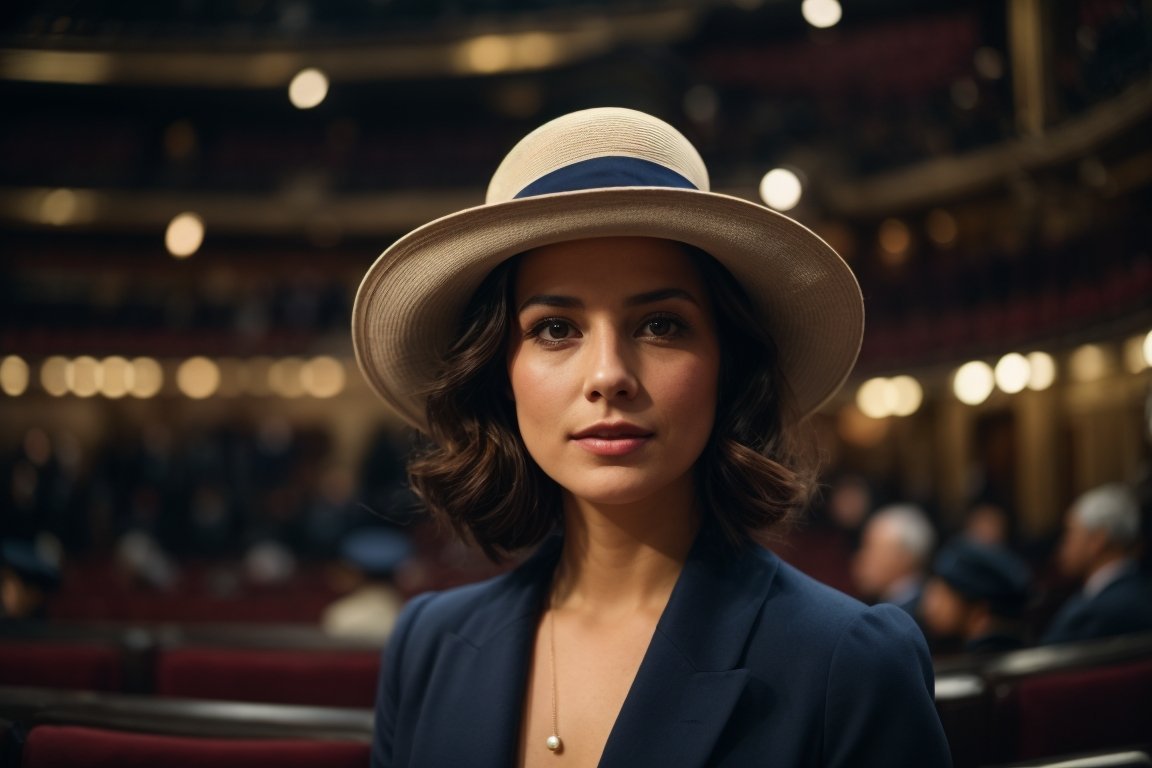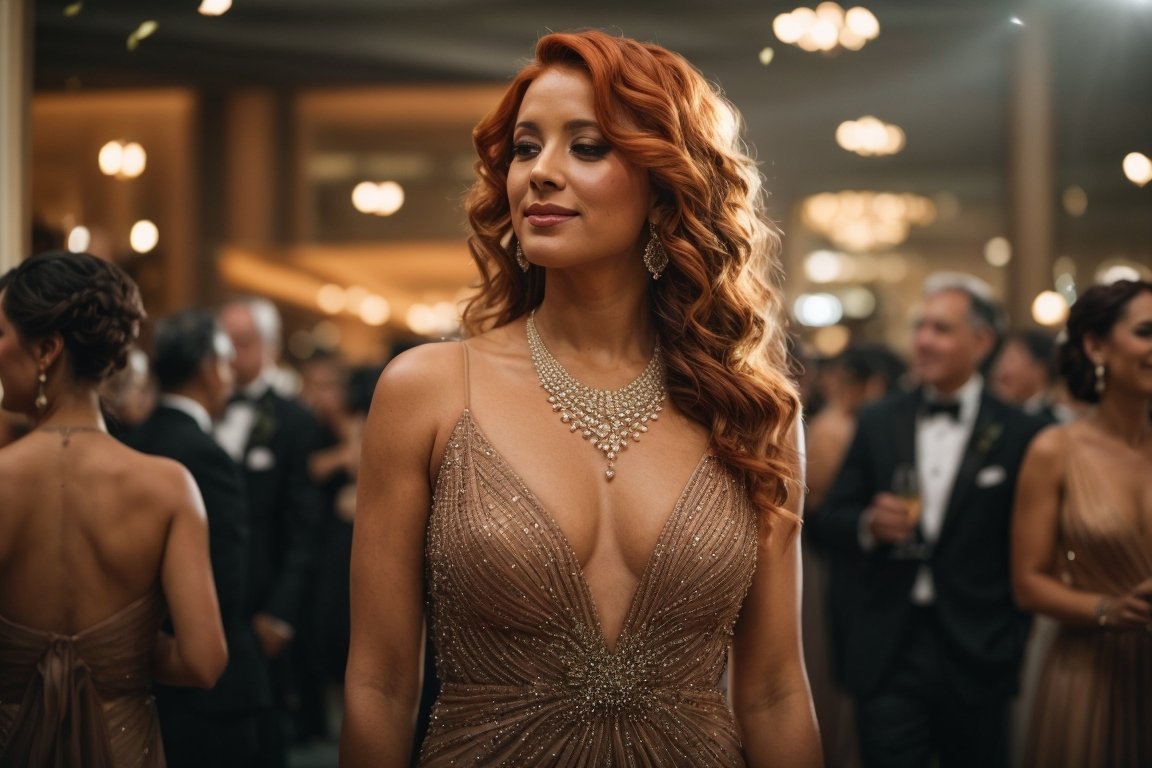Key Takeaways
- The 1920s were a time of radical change when women broke free from Victorian sensibilities. Fashion reflected this newfound freedom.
- Vibrant colors like emerald green, sapphire blue, and sunset orange came into vogue, moving away from the somber black and mauve of the previous era.
- Advances in synthetic dye technology allowed for bolder, more saturated hues than ever before.
- Flappers popularized daring new color combinations like red and pink, blue and green, yellow and purple. Mismatched ensembles were seen as fashion-forward.
- While shapeless sack dresses were the rage, waistlines crept lower and hemlines crept higher as the decade wore on.
- Masculine tailoring in tweed suits was embraced as a manifestation of female empowerment.
- The influence of the avant-garde Ballets Russes led to the widespread use of bold, contrasting colors and exotic motifs.
- New vibrant makeup like cherry red lipstick, kohl-rimmed eyes, and rouged cheeks flouted convention and shocked traditionalists.

The Roaring Twenties evoke vivid images of lively parties, secret speakeasies, and a sense of unrestrained celebration. Following the difficult years of World War I, people across the United States were eager to embrace the Jazz Age lifestyle and rediscover the joy of living.
This newfound freedom was reflected in women’s fashion, which broke free of Victorian sensibilities and embraced vibrant colors, bold designs, and daring combinations. Let’s take a closer look at the dominant hues that defined the flapper era.
Emerald Green
The somber mauves and blacks that dominated fashion in the late 1800s disappeared, making way for vibrant jewel tones such as emerald green. This rich color, often associated with vitality and growth, became popular in post-WWI fashion trends. Emerald green’s strong connection to nature evoked feelings of life and renewed energy, reflecting the collective desire for rejuvenation after the devastation of World War I.
Emerald green symbolized wealth and prosperity, both of which were plentiful during the Roaring Twenties economic boom. Whether featured in a sleek satin sheath dress or a sparkling sequined shift, this vibrant green hue captivated attention on the dance floor and at glamorous 1920s parties. When paired with gold accents, emerald green exuded vintage glamour and the luxurious feel of riches, making it a popular choice in 1920s fashion and Art Deco style.
Forest Greens
Deep forest green was a popular color choice for women’s daywear, especially in tweed suits inspired by classic menswear. This practical shade suited the newly independent career woman, reflecting both style and functionality in professional fashion trends.
Paired with browns, grays, and burgundies, forest green projected an air of seriousness and professionalism in the workplace. It was a firmly grounded shade, contrasting sharply with the effervescent jewel tones of eveningwear.
Green & Black
Some designers grounded emerald green’s verve by pairing it with black. This high contrast combination gave even the brightest emerald a touch of sophistication. Black lace and beading helped offset the sheen of satin emerald dresses, making them less flashy. Solid black accessories also reined in emerald green’s vibrancy.
Metallic Greens
Nothing said Gatsby-era glamor like metallic green. From lamé to sequins to beading, shiny treatments made emerald green shimmer and move. Metallic fringe trims on flapper dresses accentuated every sway and swing across the dance floor. Its eye-catching gleam perfectly captured the exuberance of the Jazz Age.
Sapphire Blue
Sapphire blue emerged as a defining color trend of the decade, making a significant impact on 20th-century fashion. While black dominated 19th-century clothing, blue gained popularity and soon became the leading color in modern apparel. After World War I, sapphire blue overtook navy blue as the preferred shade in post-war fashion. Its bright and bold appearance created an energizing effect for both the wearer and the observer. Additionally, blue symbolized trustworthiness and dependability—qualities that were highly valued in the aftermath of WWI’s turmoil.
Royal Blue
Women adopted a more regal air with rich royal blue gowns. Often accented with fur, velvet collars, and gold trim, royal blue connoted luxury and status. It featured prominently in eveningwear, where full-length royal blue dresses dripping in beads evoked sophistication. Royal blue gave off an aura of confidence, power, and ambition.
Powder Blue
Pastel shades of blue also came into vogue in the 1920s. Unlike the darker blues that conveyed steadfastness, powder blue imparted softness, delicacy, and charm. It created a romantic, feminine mood and became a popular choice for bridesmaids’ dresses. Combined with white, powder blue played up youth and innocence.
Blue & Silver
Some designers chose gray or silver as the perfect complement to light and dark blues. Silver beading, lace, shoes, and jewelry added a futuristic feel. Paired with turquoise blue, the combo was reminiscent of the glitz of silent films. Blue and silver epitomized the fantasy world that offered an escape from gloomy realities.

Sunset Orange
One color that saw significant renewed interest during the 1920s was orange. While a traditional fall color, sunset orange took on new vibrancy and depth thanks to synthetic dyes. Bright creamsicle orange represented joy and warmth. Softer peachy corals had a luminous, romantic allure when combined with silk or satin. Orange made a bold statement, pushing fashion boundaries.
Burnt Orange
Deeper burnt oranges lent a more exotic, earthy tone. Inspired by far-off lands, rich burnt orange conjured up images of ancient temples and clay pottery. Embroidered and beaded evening gowns in burnt orange colors mirrored the Orientalist aesthetic of the Ballets Russes. Its warmer tone also blended well with autumnal browns, yellows, and greens.
Coral Pink & Orange
Pairing coral pink with orange created a tropical vibe evocative of warm island breezes and sunshine. Blended together in ombre satin dresses, the vibrant duo made women stand out from the crowd. Orange and pink also challenged style norms by mixing colors from opposite sides of the color wheel.
Black & Orange
Another unconventional combination the era embraced was orange with black. Deep orange and black evoked the extravagant look of monarch butterflies. Orange provided the perfect accent color to offset sleek black dresses. Combined with the geometric Art Deco movement, the duo created a striking, modernist aesthetic.
Style Innovations
Beyond introducing radically new colors, 1920s fashion made other bold moves that changed clothing forever. Understanding these innovations provides deeper insight into how color functioned during the decade.
Mismatched Colors
While color coordination had long been fashionable, the 1920s joyfully mixed contrasting or mismatched colors. Instead of colors blended subtly within a single outfit, colors from opposite sides of the color wheel were paired in jarring ways. Red dresses accessorized with pink hats, blue gloves, and green shoes were markers of progressive fashion.
Waistlines & Hemlines
The straight, sack-like shift dresses of the early 1920s gradually gave way to more shapely silhouettes accentuating the hips and legs. Waistlines lowered and hemlines rose to reveal more skin. Colors were used strategically to highlight these sensuous new shapes and proportions. Dark colors slimmed while light hues broadened.
Masculine & Feminine
Women embraced masculine styles like tweed suits in earth tones as symbols of newfound freedom and power. But ultra-feminine dresses in pastels, metallics, and florals also abounded. The color palette expressed the complex mix of strength, independence, and romance women wanted to project.
Exotic Motifs
The discovery of King Tut’s tomb fueled a fascination with Ancient Egypt. Near Eastern patterns and designs appeared on dresses, often in sandy orange, burgundy, or teal hues. Textiles and costumes from Ballets Russes productions like Scheherazade incorporated bold new Eastern color schemes and motifs into 1920s fashion.
Avant-Garde Influence
Led by Léon Bakst, the Ballets Russes revolutionized color use in costumes and stage decor. Lush ombre fabrics, clashing color combinations and exotic patterns provided inspiration for off-the-rack clothing. Bakst proved color could be emotional and symbolic, not just decorative.

Makeup Palette
Along with dresses, makeup looks also grew far more colorful. Face powders came in blue, lavender, pink and yellow hues rather than just traditional flesh tones. Eyes rimmed dramatically in kohl defined the iconic flapper look. Most revolutionary was the widespread embrace of red lipstick.
Red Lipstick
While dark red lips shocked Victorian sensibilities, by the 1920s they were a symbol of liberated women. Lipstick choices ranged from bright cherry to deep burgundy. Applying lipstick in public was itself a daring act of rebellion. Colorful lips became tantalizing canvases for self-expression.
Rosy Cheeks
Pale skin was highly prized in the 19th century. But the 1920s ushered in a craze for tanned, glowing complexions. Cream rouges created healthy, rosy cheeks. Mauve and pink tints blended seamlessly for a natural sun-kissed flush. Some even applied rouge in dramatic spot shades on the temples, chin, and forehead like silent film stars.
Kohl Eyes
Smudgy, smoky kohl-lined eyes became synonymous with flappers. Black and brown kohl pencils rimmed both upper and lower lids, elongating the eyes. Paired with penciled-in brows, the dark shadowy effect gave women a mysterious, alluring aura. The style rebelled against conventions of natural makeup.
Colorful Compacts
Intricately designed compacts were colorful works of art. Enameled cases came in every hue imaginable, many with geometric Art Deco patterns. Stylish women carried these bright accessories even when empty of powder. Compacts proclaimed one’s unique tastes or moods through color preferences.
Tweed Suits
For daywear, nothing embodied the 1920s shift in women’s fashion more than tweed suits. The decade saw an explosion in women entering the workforce, and pursuing education and careers. Though still a male-dominated realm, ladies adapted menswear into powerful feminist fashion statements.
Mint Green
Pastel tweed in shades like mint green or lilac purple lent a soft femininity to traditionally masculine suiting. Frothy bow blouses and straight Tea-length skirts also maintained a girlish charm. Mint green evoked freshness and innocence but also determination and poise.
Gray & Brown
More sober suits came in versatile neutrals like gray and brown tweed. Paired with crisp white shirts and masculine ties, women echoed boardroom dress codes. Browns and Grays projected professionalism and seriousness. Though conforming on the surface, suits enabled women to infiltrate male spaces.
Checks & Plaids
Many tweed suits incorporated traditional patterns like checks, plaids and herringbones. Unmarried young women often wore menswear-inspired suits with wide lapels and padded shoulders. Checks and plaids blended in while allowing women to stand out intellectually rather than physically.
Masculine Accessories
Gone were the mauves and blacks of the late 1800s. In their place came jewel tones like emerald green, which symbolized vitality and growth. Its association with nature evoked a sense of life and energy that people yearned for after the destruction of WWI.
Sober Color Pairings
Designers recommended subdued color pairings for tweed suits like navy and black, tan and brown, or slate blue and gray. Contrasting colors were applied minimally as piping or collar accents. Professional tweed suits required a serious, down-to-business color palette that mirrored masculine sobriety.

Sheer Fabrics
Advances in textile technology led to the creation of lightweight crepes and satins. Clothing could now be semi-transparent, another break from Victorian conventions of modesty. When colored, these diaphanous fabrics took on a radiant, almost ethereal glow.
Pastel Crepe
Crepe, a crinkly lightweight fabric, came in gossamer pale shades ranging from lemon chiffon to lilac purple. Crepe gave a subtle texture and muted the brightness of pastels slightly. Cool in summer, flowing crepe dresses were often worn without restrictive undergarments.
Metallic Lurex
Lurex, a newly invented metallic fabric, added glossy dazzle. Silver and gold Lurex thread was woven into shimmering evening dresses. Iridescent fabrics captured and reflected light, even in dark, smoky speakeasies. Lurex comes in every hue for maximum eye-catching glamour.
Sheer Black
Black crepe and lace also took on new allure when fashioned into barely-there dresses. Seductive sheer black fabric revealed just hints of skin. Transparency is titillated without exposing too much. Black brought sophistication to what might otherwise have seemed scandalous.
Silk Chiffon
Floaty silk chiffon billowed dramatically when dancing. Chiffon could be made very lightly so multiple layers did not overwhelm. Sophisticated beading and embroidery adorned some chiffon dresses. Every color from red to blue to silver took on a gauzy, ethereal effect.
Rayon
The development of rayon-added sheen at an affordable price. Unlike silk, rayon could be machine-washed and dried. Rayon retained vivid colors through repeated laundering. Available in all colors and prints, rayon enabled women of all incomes to embrace the lightweight tunics and gowns in vogue.
By breaking with the rigid past, women’s fashion in the 1920s freed itself to embrace vibrant colors, provocative designs, and uninhibited chic.
These innovative clothing choices gave women new ways to express independence, power, and individuality through personal style. The iconic flapper look manifested the irrepressible joy, defiance, creativity, and progressive thinking that defined this remarkable decade of change.
Summary Table
| Color | Mood | Type of Clothing |
|---|---|---|
| Emerald Green | Vitality, Growth, Prosperity | Satin & sequin evening dresses |
| Sapphire Blue | Trust, Dependability, Confidence | Velvet & fur trimmed evening gowns |
| Sunset Orange | Joy, Warmth, Boundary-Pushing | Crepe & chiffon dresses |
| Pastel Tweeds | Softness, Femininity, Determination | Suits with straight skirts |
| Sheer Crepe | Seductive, Ethereal, Liberating | Flowy, unrestrictive dresses |
| Cherry Red Lipstick | Defiance, Self-Expression, liberation | Makeup for day & evening |
Conclusion
The Roaring Twenties were transformative years for women’s fashion and its use of color. New dye technologies and textile inventions opened up thrilling possibilities for vivid hues, tactile fabrics, and revealing silhouettes.
Youthful flappers flung aside old rules about color compatibility as they fearlessly mixed clashing brights like red and pink or blue and green. evenings simmered with jewel-toned satins in emerald, sapphire, and ruby. Days were for making bold feminist statements in tailored tweed suits.
Makeup palettes expanded dramatically from simple flesh tones to include blue powders, orange rouges, and scarlet lipsticks. Clothing colors went from symbolizing status and mourning to expressing vibrant life.
For the first time, vibrant color was freely accessible across classes thanks to synthetic dyes. The decade was a watershed moment of self-definition, captured aesthetically in its groundbreaking palette.

Frequently Asked Questions
How did World War I influence 1920s color trends?
After the devastation of WWI, people longed for uplifting, vibrant colors that represented life, hope, and joy. Bright emerald greens, sapphire blues, and coral oranges replaced the somber greys and mauves favored previously.
What technological innovations allowed for new colors?
Advances in synthetic dyes and fabrics like rayon allowed for saturated, vivid shades not possible with natural dyes. Metallic Lurex thread created shiny, shimmery fabrics.
Why did flappers wear mismatched colors?
Flappers purposefully combined clashing colors like red and pink as a way to rebel against old traditions of color compatibility. Mismatched ensembles showed their avant-garde fearlessness.
How did makeup change from Victorian-era looks?
Makeup became much more colorful. Red lipstick, rouged cheeks, blue and lavender face powders, and kohl-rimmed eyes broke with norms of natural makeup.
How did dances like the Charleston affect hemlines?
To allow freedom of movement for dances like the Charleston, flapper dresses featured shorter hemlines that rose steadily throughout the 20s and showed more leg.
How did men’s suits influence flapper fashion?
Many flappers adopted masculine-style suiting in tweed and plaids as a sign of empowerment. But details like mint greens and lilacs feminized them.
What was the impact of exotic Ballets Russes costumes?
Bold Eastern color schemes, patterns, and motifs from Ballets Russes productions inspired avant-garde color combinations in women’s clothing.
How did textile advances impact eveningwear?
Lightweight crepe, chiffon, and rayon allowed for airy, sheer dresses in vibrant jewel tones or ethereal pastels for the evening.
Why were grey and brown tweeds popular?
For the newly independent career girl, grey and brown tweed suits conveyed professional seriousness and competence within male-dominated offices.
How did silhouette shapes change over the decade?
Hemlines rose and waistlines lowered to show more leg. Combined with vibrant colors, clothes began accentuating women’s bodies more sensuously.

What did blue represent in the 1920s?
Unlike in the Victorian era, blue evolved from a mourning color to one representing steadfastness and dependability. Light blues also conveyed softness and charm.
How did flappers use red lipstick as a symbol?
Red lipstick represented liberation and defiance of traditional gender roles. Applying it publicly was a daring, rebellious act.
Why were compacts an important accessory?
Intricately decorated compacts enabled women to touch up makeup like vivid rouges. Carrying a bright compact proclaimed one’s unique style and personality.
How did World War I impact material availability?
WWI and new textile technologies led to innovative lightweight fabrics like rayon and crepe. New sheer fabrics created a luminous glow when colored.

Anna West, the visionary behind Clothes Color Guide, is our go-to for all things fashion. Merging the finest of runway trends with everyday style, she demystifies the world of color and pattern. While clothing is her mainstay, Anna also shares insights on interior design, pet care, and relationship advice. Dive into her articles and emerge with a vibrant perspective on style and life.
Reviewed By: Joanna Perez and Marcella Raskin
Edited By: Lenny Terra
Fact Checked By: Sam Goldman
Photos Taken or Curated By: Matthew Mansour
